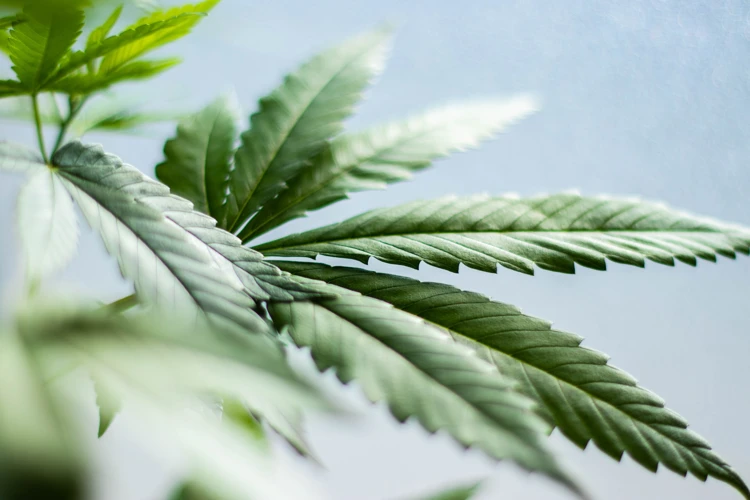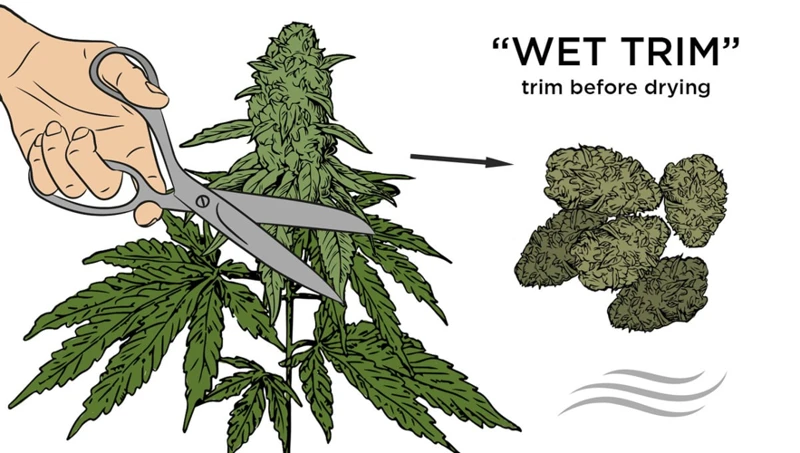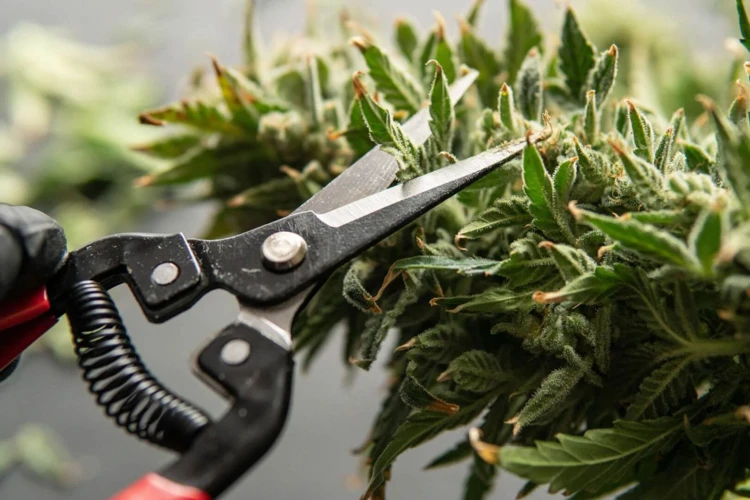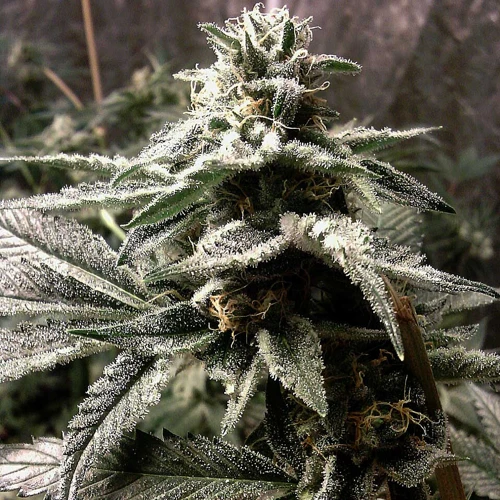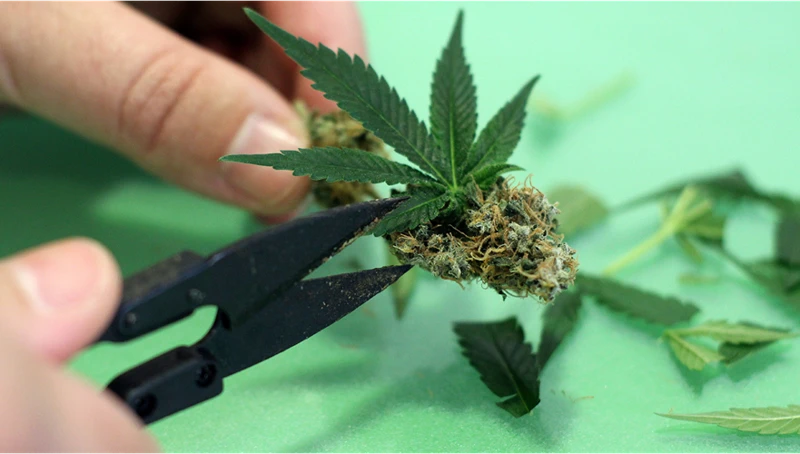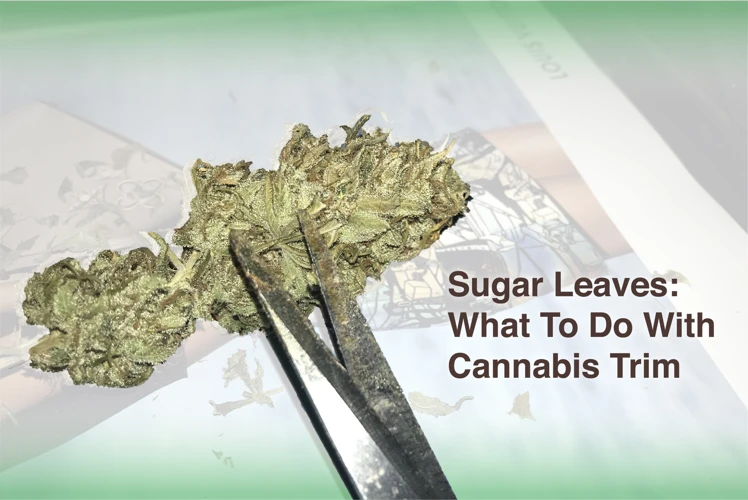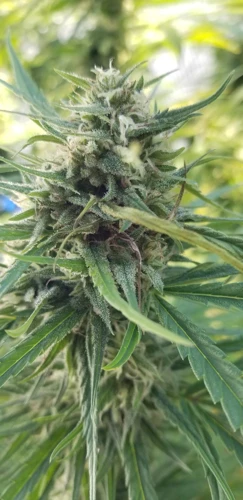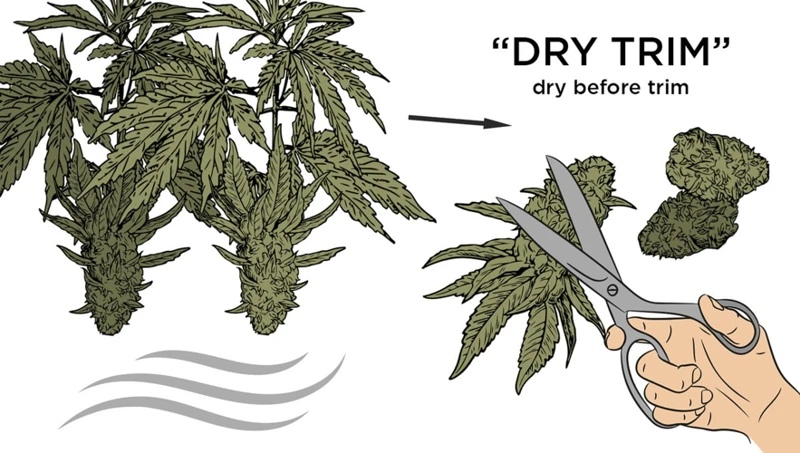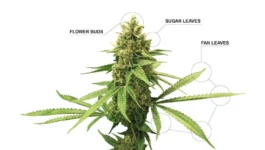
Trimming Sugar Leaves: Tips and Techniques for Growing the Best Cannabis
Introduction
Contents
As any cannabis grower knows, the process of harvesting and preparing the buds is just as important as the cultivation itself. One crucial step in this process is trimming the sugar leaves, which can affect both the final appearance and potency of the finished product. But for those new to the art of trimming, the process can seem daunting. Fear not, as we will guide you through everything you need to know about trimming sugar leaves, from when to do it to the various techniques and tools at your disposal.
What are Sugar Leaves?
Sugar leaves are small leaves that grow around the cannabis buds during the flowering stage of plant growth. They are called so because they are covered in trichomes, which give them a sugary appearance. Although sugar leaves do contain some of the psychoactive compounds found in the buds, they are not as potent and are typically trimmed off before consumption.
| What are Sugar Leaves? |
|---|
| Small leaves growing around cannabis buds |
| Covered in trichomes, giving them a sugary appearance |
| Contain some psychoactive compounds but not as potent as buds |
| Typically trimmed off before consumption |
Knowing how and when to trim sugar leaves is an important part of the cannabis growing process, and it can affect the overall quality and potency of the final product. Trimming can be done both during the flowering stage and after harvest time, using a variety of tools and techniques such as wet and dry trimming and bucking. In the next sections, we will explore each of these methods in more detail and provide tips for successful sugar leaf trimming, as well as ways to repurpose the trimmed leaves. It is important to note that avoiding common trimming mistakes is integral in achieving the best quality final product. For further information, check out our guide to avoiding trimming mistakes.
When to Trim Sugar Leaves
As a cannabis grower, you may be unsure about when to start trimming the sugar leaves from your plants. The timing of this process is crucial for ensuring the quality and potency of your final product. There are generally two major stages when you should be trimming: during the flowering stage and at harvest time. Knowing when and how to effectively remove these leaves can make a significant difference in the overall quality of your cannabis.
During Flowering Stage
The Flowering Stage: When to Trim Sugar Leaves
During the flowering stage, the cannabis plants begin to produce buds that are full of trichomes. These trichomes contain the cannabinoids and terpenes that give the plant its potency and flavor. It is during this stage that many growers choose to trim the sugar leaves, which are the small leaves that surround the buds.
Why Trim Sugar Leaves During Flowering
Trimming sugar leaves during the flowering stage has several benefits. First, it can improve the overall appearance of the buds. Trimming away the excess leaves can make the buds look more attractive and visually appealing. Second, trimming the sugar leaves can help improve the air circulation around the buds, which can reduce the risk of mold and other fungal infections. Finally, trimming the sugar leaves can help improve the potency and flavor of the buds by removing any excess plant material that may interfere with the trichomes.
When to Trim Sugar Leaves During Flowering
When it comes to trimming sugar leaves during the flowering stage, timing is everything. Trimming too early can stress the plant and reduce its overall yield, while trimming too late can make the process more difficult and less effective. Here is a table summarizing when to trim sugar leaves during the flowering stage:
| Stage of Flowering | When to Trim |
|---|---|
| Early Flowering | Wait until buds have formed and trichomes are visible |
| Mid-Flowering | Trim any large leaves covering the buds |
| Late Flowering | Only trim leaves that are blocking light or air circulation |
As you can see, the timing of trimming during the flowering stage can vary depending on the stage of growth of the plant. It is important to observe the plant closely and only trim as necessary to ensure that the plant remains healthy and produces high-quality buds.
Harvest Time
Harvesting time is crucial when it comes to trimming sugar leaves. If you harvest too early, the trichomes may not have developed fully, leading to undesirable effects. On the other hand, harvesting too late may lead to overripe buds that are difficult to handle during the trimming process.
So, how do you know when it’s time to harvest?
There are several signs that you can look out for to determine the best time to harvest. First, keep an eye on the color of the pistils. When they change from white to reddish-brown, it’s a sign that the buds are maturing. Additionally, you can use a magnifying glass to check the color of the trichomes. The trichomes should be cloudy, with some amber-colored trichomes indicating that the buds are at their peak potency.
What happens after harvesting?
Once you have harvested your crop, it’s time to begin trimming sugar leaves. You can trim the leaves while the plants are still damp or wait till they dry out. It all depends on the method you choose to use for trimming. Though it’s recommended to wait until the plants are completely dry to avoid any unwanted moisture in the buds.
What should I do with the trimmed sugar leaves?
Trimmed sugar leaves can be used to make edibles or concentrates, adding value to your crop. It’s important to note that sugar leaves contain a lower concentration of cannabinoids than the buds. You may need to use more to achieve the desired effects. But, it’s a great way to maximize the yield of your cannabis harvest.
Harvesting at the right time is the first step in trimming sugar leaves. Ensure that you monitor the pistils and trichomes to determine the best time to harvest. Don’t forget that the trimmed sugar leaves can still be useful, particularly for making edibles or concentrates, so be sure to save them too.
Tools for Trimming Sugar Leaves
Trimming sugar leaves can be a tedious and time-consuming process, but having the right tools on hand can make all the difference. With a variety of tools available for trimming, it can be overwhelming to decide which ones to use. However, having access to a few key tools will make the job much easier and efficient. Let’s take a look at some of the essential tools for trimming sugar leaves.
Scissors
When it comes to trimming sugar leaves, one of the most important things you will need is a good pair of scissors. Not just any scissors will do, however. You need scissors specifically designed for trimming cannabis plants. These scissors are incredibly sharp and precise, allowing you to cut through the leaves with ease.
Here are some things to keep in mind when shopping for trimming scissors:
| Blade Type | Look for scissors with straight, curved, or serrated blades. Straight blades are good for precise cuts, while serrated blades are better for cutting through larger leaves. Curved blades allow you to get closer to the plant without damaging the buds. |
| Blade Size | The size of the blade you choose will depend on the size of your plants. If you have larger plants, you may want to opt for longer blades, while smaller plants may require shorter blades. |
| Comfort | Since trimming can be a time-consuming process, you want to make sure your scissors feel comfortable in your hands. Look for scissors with soft-grip handles or ergonomic designs to reduce hand fatigue. |
| Cleanliness | It’s important to keep your trimming scissors clean and free of debris. Look for scissors that can be easily taken apart for cleaning, or consider getting a specialized cleaning solution to keep them in top shape. |
Investing in a good pair of trimming scissors can make all the difference when it comes to producing high-quality cannabis buds. Make sure to choose scissors that are suited to your needs and preferences, and take good care of them to ensure they last for many harvests to come.
Trimming Machines
When it comes to trimming sugar leaves, using trimming machines can make the process much faster and efficient. These machines are designed to remove the excess sugar leaves from the buds with precision and speed. Here are some of the most popular types of trimming machines to consider:
- Hand-Crank Trimming Machines: These machines are operated by hand and require the user to manually rotate a crank to trim the leaves. They are relatively inexpensive and can be a good option for small-scale growers.
- Electric Trimming Machines: These machines use electricity to power the trimming blades and can trim large amounts of buds quickly. They are more expensive than hand-crank machines but are more efficient for larger grows.
- Bowl Trimmers: These machines use a spinning bowl and a set of sharp blades to trim the leaves off the buds. They are very effective and can trim large amounts of buds in a short period of time. However, they tend to be the most expensive option on the market.
While trimming machines can be a great tool for trimming sugar leaves, it’s important to note that they are not foolproof. It’s still important to inspect the buds after they’ve been trimmed by the machine to ensure that all the excess leaves have been removed. Additionally, some strains may require hand-tailored trimming to achieve the desired results.
Ultimately, using a trimming machine is a personal preference that depends on factors such as grow size and budget. It’s important to do your research and choose the trimming method that works best for you and your crop.
Techniques for Trimming Sugar Leaves
When it comes to trimming sugar leaves, there are a few techniques that growers can use to achieve optimal results. These techniques involve different tools and methods, such as wet trimming, dry trimming, and bucking. Each technique has its own benefits and drawbacks, and the choice ultimately depends on the grower’s preference and specific needs. In this section, we’ll explore each technique in more detail and provide step-by-step instructions on how to execute them effectively. So, let’s dive in and discover which technique will work best for your cannabis trimming needs.
Wet Trimming
Wet trimming is a technique for trimming sugar leaves that involves removing the leaves while the flowers are still wet. This method is popular because it is believed to make the process faster and easier. However, some growers argue that it can lead to a loss of flavor and potency in the final product.
Here is a step-by-step guide for wet trimming:
| Step | Action |
|---|---|
| 1 | Cut the Branches: After harvesting, cut the branches into manageable sizes. |
| 2 | Trim Off the Sugar Leaves: Using a pair of sharp scissors, carefully trim off the sugar leaves from the flowers. Make sure to only remove the leaves that are necessary, as over-trimming can impact the final product’s quality. |
| 3 | Rinse the Flowers: Once the trimming is complete, rinse the flowers with cool water to remove any remaining plant matter. |
It’s important to note that wet trimming can be messy and time-consuming. The wet leaves can stick to the scissors or the trimmer, making it harder to get a clean cut. Additionally, wet trimming may not be the best method if you plan to use the trimmed leaves for concentrates, as the excess moisture can impact the quality of the final product.
Wet trimming can be an effective method for removing sugar leaves, especially if you are looking for a faster and easier process. However, it’s important to consider the potential impact on the final product’s flavor and potency, as well as the potential challenges involved in the process.
Dry Trimming
Dry trimming is a method of removing sugar leaves from cannabis buds after the flowers have been dried. This technique is preferred by many growers because it preserves the trichomes and terpenes that are responsible for the plant’s aroma and potency. However, it can be more time-consuming than wet trimming.
Tools required: Sharp scissors, a clean and dry work surface, and a container for collecting the trimmings.
Step 1: Dry the flowers
Before you begin dry trimming, the buds must be fully dried. This can take anywhere from five to 14 days, depending on the humidity and temperature of the drying environment. Once the buds are dry, they will be less sticky and easier to handle without damaging the trichomes.
Step 2: Cut the branches and begin trimming
Once the buds are dry, trim each branch from the plant and remove any large fan leaves. Use sharp scissors to carefully trim the remaining sugar leaves from the buds, leaving as much of the trichomes intact as possible. It’s important not to trim too much or too aggressively, as this can damage the buds and reduce the potency. Take your time and work systematically, trimming each bud individually before moving on to the next.
Step 3: Collect the trimmings
Save the sugar leaves that you have removed, because they can still be used in cooking, infusions, or to create concentrates. Place the trimmings in a container and store them in a cool, dry place until you’re ready to use them.
Dry trimming requires patience and attention to detail, but can produce high-quality cannabis with a strong aroma and flavor. Try both wet and dry trimming methods to find the one that works best for you and produces the results you desire.
Bucking
Bucking is another technique that can be used for trimming sugar leaves. It involves using a machine to remove the majority of the leaves from the buds. Here is a step-by-step guide on how to buck sugar leaves:
| Step 1 | Cut the branches and remove large leaves |
| Step 2 | Use a trimming machine |
| Step 3 | Finish by hand |
Step 1: Cut the branches and remove large leaves
To begin the process, cut the branches that have buds with sugar leaves that need to be trimmed. Once you have cut the branches, remove the large fan leaves from the buds.
Step 2: Use a trimming machine
Next, use a trimming machine to remove the majority of the sugar leaves from the buds. A trimming machine is a mechanical device that can help speed up the trimming process. The machine will remove the majority of the leaves, leaving behind only a few that may need to be removed by hand.
Step 3: Finish by hand
After using the trimming machine, finish the process by hand. Inspect the buds and remove any remaining sugar leaves using scissors or other trimming tools. This step is important to ensure that the buds are properly trimmed and ready for consumption.
Bucking is a quick and efficient way to trim sugar leaves, and can be particularly useful for large harvests where a lot of buds need to be trimmed in a short amount of time. However, while a trimming machine can speed up the process, it is important to take the time to finish by hand to ensure the buds are properly trimmed.
How to Wet Trim Sugar Leaves
Trimming sugar leaves can be a delicate process but with the right tools and techniques, it can be done efficiently. Wet trimming is one of the methods used to remove excess sugar leaves from harvested cannabis. This process involves cutting the branches and removing the leaves before rinsing the flowers. In this section, we’ll walk you through the steps for wet trimming your sugar leaves so you can achieve a clean and polished final product. Ready to get started? Let’s dive in.
Step 1: Cut the Branches
The first step in wet trimming sugar leaves is to cut the branches. This involves using a pair of scissors or garden shears to carefully cut the branches from the plant. It’s important to be gentle during this process to avoid damaging the buds or breaking off any trichomes.
- Choose the right time: Cut the branches when the plants are well hydrated, either in the early morning or late evening, before the heat of the day.
- Use sharp tools: This ensures a clean cut that won’t crush the stem or damage the remaining plant.
- Cut at the node: This is where the branches meet the main stem, so it’s important to cut as close to the node as possible to minimize damage to the plant.
- Leave some stem intact: Leave enough stem on the branch to make it easy to handle during the trimming process, but not so much that it takes up unnecessary space.
- Remove damaged or yellowing leaves: This helps to focus the trimming energy on the sugar leaves and ensures that there aren’t any unsightly leaves left over.
By following these steps, you can ensure that you have healthy, well-trimmed branches for your wet trimming process.
Step 2: Trim Off the Sugar Leaves
After cutting the branches, it’s time to trim off the sugar leaves. This is an important step in the wet trimming process because it helps to remove excess moisture from the flowers. To do this, you’ll need a pair of sharp scissors and a patience!
Step 1: Hold the branch gently, so as not to damage the delicate flowers. Take a close look at the sugar leaves and identify which ones need to be trimmed. These are the large leaves that are covered in trichomes.
Step 2: Using the scissors, carefully snip off the sugar leaves at the base of the stem. Take care not to cut too close to the flower, or you risk damaging it. Remember, you can always go back and trim more later, so it’s better to be cautious at this stage.
Step 3: Continue trimming each flower in this manner, taking your time and being careful to avoid damaging the delicate buds. As you work, try to keep the flowers as dry as possible, wiping away any excess moisture with a clean cloth.
Step 4: Once you’ve trimmed off all the sugar leaves, take a step back and admire your work! You should be left with beautifully trimmed flowers that are ready for the next step in the drying process.
Tip: If you’re having trouble getting close to the flowers with your scissors, try using a pair of small trimming scissors designed specifically for cannabis trimming. These can help you get into tight spaces and make more precise cuts.
Step 3: Rinse the Flowers
After trimming off the sugar leaves, rinsing the flowers becomes an important step to ensure their overall cleanliness. Rinsing the flowers ensures that no residual debris or contaminants will be present on the final product.
To rinse the flowers, you will need a sink, a large bowl and clean water. Follow these easy steps to rinse your flowers after trimming:
- Take the clean bowl and fill it up with water. Ensure that your water is lukewarm and it should not be too hot or too cold, as this can damage the flowers.
- Place the trimmed flowers gently inside the bowl and let them sit for about ten minutes. This will loosen up any remaining impurities and contaminants on the flowers.
- Gently swirl the flowers around in the bowl, ensuring that every flower receives a thorough rinse. Be careful not to damage your buds during this step, as they are still delicate at this stage.
- Remove the flowers from the water and place them on a dish to dry. Depending on the humidity where you live, this could take a few hours or longer.
Once your flowers are dry, they are ready to be cured, stored and ultimately enjoyed! With the sugar leaves removed and the flowers fully rinsed, you can rest easy knowing that you are consuming a clean and very high-quality product.
How to Dry Trim Sugar Leaves
Now that we’ve covered wet trimming, let’s delve into another popular technique for trimming sugar leaves – dry trimming. Dry trimming involves allowing the flowers to dry prior to beginning the trimming process. This can allow for a more detailed trim, as the sugar leaves will be more brittle and easy to remove. However, it’s important to approach dry trimming with caution, as the flowers can easily become too dry and crumble during the trimming process. In this section, we’ll break down the steps for successfully dry trimming your harvested cannabis flowers.
Step 1: Dry the Flowers
Step 1: Before starting to dry trim the sugar leaves, it’s important to properly dry the flowers. Begin by hanging the branches upside down in a dark, dry, and well-ventilated room. This process usually takes around 7-10 days, but can vary based on the humidity levels in the room.
Step 2: Avoid stacking the branches on top of each other during drying as they may develop mold or mildew. Make sure the room is kept at a temperature of around 60-70 degrees Fahrenheit (15-21 degrees Celsius) and humidity is kept between 45-55%.
Step 3: Once the flowers are dry, remove them from the branches and trim off excess stems or leaves. Handling dry flowers can be delicate, so be sure to handle them with care to avoid damaging the buds or trichomes.
Step 4: Take a moment to inspect the flowers for any signs of damage or disease. This is also a good time to remove any remaining large fan leaves that were not removed during the earlier stages of trimming.
Step 5: With the flowers prepped and ready, it’s time to begin the dry trimming process. This process involves carefully removing the sugar leaves with a pair of sharp trimming scissors, leaving only the manicured buds behind.
Step 2: Cut the Branches and Begin Trimming
Once the flowers are completely dry, it’s time to begin the trimming process. This involves removing the sugar leaves that surround the buds, which can be done using a pair of sharp scissors or a trimming machine. Follow these steps to dry trim your sugar leaves:
Step 1: Cut the branches from the plant using a sharp and precise tool such as pruning shears. Hold the branch gently to avoid damaging the leaves and buds.
Step 2: Begin trimming the sugar leaves away from the buds. Hold the branch by the stem and use your scissors to carefully remove any excess leaves from the flowers. You must be cautious not to cut too close to the buds and avoid damaging them.
Step 3: Collect the trimmed sugar leaves in a container and set them aside for later use. It may be time-consuming to hand-trim dried buds, but the end result is typically a higher-quality product that looks more appealing and has better potency.
It’s essential to ensure that your tools are sharp, clean, and in good condition before beginning the trimming process as dull blades can cause damage to the buds. Take your time to do the job correctly, and you’ll be rewarded with a better-looking and more potent final product.
Step 3: Collect the Trimmings
After you have trimmed all the sugar leaves, it is time to collect the trimmings. The trimmings are the leaves that you have removed from the flower and can still be used for various purposes. Here are the steps to properly collect the trimmings:
- Step 1: gather all the trimmed sugar leaves from your trimming surface.
- Step 2: use a fine mesh screen or a silk screen to sift through the trimmings. This will help to remove any unwanted material such as stems and other debris.
- Step 3: place the sifted trimmings into an airtight container or bag. This will help to preserve the freshness of the trimmings for future use.
- Step 4: label the container or bag with the date and strain of the trimmings. This will give you an idea of how long the trimmings have been stored and which strain they came from.
Remember that even though sugar leaves are considered waste material, they still contain a small amount of THC and can be used for making edibles and concentrates. Properly collecting the trimmings will ensure that you have a good supply of material that can be used for future endeavors.
How to Buck Sugar Leaves
If you’re dealing with a large amount of harvested cannabis plants, using a trimming machine is a great option for saving time and effort. Bucking is the process of removing the sugar leaves and trimming the buds off the branches. This method requires specific tools and equipment, but it can speed up the trimming process immensely. Let’s take a look at the steps involved in bucking sugar leaves from the cannabis plants.
Step 1: Cut the Branches and Remove Large Leaves
Before you can begin bucking your sugar leaves, you must first cut the branches and remove the large fan leaves. This process can be broken down into the following steps:
- Gather your materials: Before you begin trimming, it is important to make sure you have all the necessary tools on hand. This may include a pair of sharp scissors or pruning shears, gloves, and a clean work surface.
- Choose your plants: Select the plants you wish to trim, and carefully inspect them for signs of damage or disease. It is best to focus on plants that are healthy and mature, and to avoid any that are still in the early stages of growth.
- Cut the branches: Using your scissors or pruning shears, carefully snip the branches from the plant, making sure to leave a few inches of stem attached. This will help to make it easier to handle the plants as you work.
- Remove large leaves: Next, use your fingers or a sharp knife to remove any large fan leaves from the branches. These are the leaves that are typically used for photosynthesis, and they can be easily identified by their size and shape. Removing them will make it easier to access the sugar leaves, which are the smaller leaves that grow close to the flowers and are rich in trichomes.
By following these steps, you will be well on your way to trimming your sugar leaves and creating high-quality edibles and concentrates. It is important to take your time and work carefully, as rushing the process can lead to damage or spoilage of your plants. With a little bit of patience and care, however, you can easily master the art of trimming sugar leaves and unlock a world of creative possibilities.
Step 2: Use a Trimming Machine
One option for trimming your sugar leaves is to use a trimming machine. This can be a much faster method than doing it all by hand, but it does require the expense of purchasing or renting the machine.
Here are the steps for using a trimming machine:
- Step 1: Set up the trimming machine in a clean and well-lit area. Always refer to the manufacturer’s instructions for proper setup and use.
- Step 2: Take your dried branches and feed them carefully into the machine. The machine’s spinning blades will quickly trim away the sugar leaves, leaving behind only the buds.
- Step 3: Be sure to collect the trimmed leaves as they come out of the machine, as they can be used for making edibles or concentrates later.
It’s important to note that even with the use of a trimming machine, there may still be some residual sugar leaves left on the buds that will need to be trimmed by hand. Also, different machines may have different capabilities and may require different cleaning and maintenance processes, so always consult the specific instructions for the machine you are using.
Step 3: Finish by Hand
After using a trimming machine to remove the majority of the sugar leaves, it’s time to finish the job by hand. This step involves removing any remaining leaves that the machine may have missed. Here are the steps for finishing the trimming process:
1. Inspect the buds: Before beginning the manual trimming process, inspect the buds to determine which areas still have sugar leaves that need to be removed.
2. Use scissors: Use a pair of sharp scissors to carefully trim away any remaining leaves. Trim as close to the bud as possible without damaging it.
3. Keep buds in the right orientation: As you trim, keep the buds in the correct orientation to prevent them from getting damaged. For example, always holding the bud by the stem and working on the side without the stem will help keep the bud in the right position.
4. Tidy up: After trimming, take a moment to tidy up the buds. Remove any stray leaves or stems that may still be hanging on.
5. Repeat the process: Continue to inspect the buds, and repeat the process of hand trimming as needed until all of the sugar leaves have been removed.
By following these steps, you can ensure that the buds are properly trimmed and ready for use. Be sure to take your time and work carefully to ensure that you don’t damage the buds during the trimming process.
What to Do with Trimmed Sugar Leaves
Once you’ve successfully trimmed the sugar leaves from your marijuana plant, you may be wondering what to do with them next. These small leaves contain trichomes and cannabinoids, making them valuable for consumption. Don’t let them go to waste! There are various ways you can use these trimmed sugar leaves to create edibles or concentrates. In this section, we’ll explore some of the best ways you can utilize your newly trimmed sugar leaves to make the most of your cannabis harvest.
Make Edibles
One of the ways you can use trimmed sugar leaves is to make edibles. These leaves are packed with trichomes, which contain cannabinoids such as THC and CBD, making them a valuable resource for cooking. Here are some ideas for how you can use your trimmed sugar leaves to create tasty treats:
- Infused Butter or Oil: Melt butter or coconut oil in a pot and add in your trimmed sugar leaves. Let them simmer for several hours to extract the cannabinoids, and then strain out the leaves. Use the infused butter or oil in recipes for baked goods, stir-fries, and other dishes.
- Tea or Tinctures: Add your trimmed sugar leaves to a hot cup of water or alcohol to make a tea or tincture. This is an easy and effective way to consume the cannabinoids without having to do any cooking.
- Baked Goods: Use your infused butter or oil to make baked goods such as brownies, muffins, or cookies. You can also add the trimmed leaves directly into the batter or dough if you prefer a more earthy flavor.
- Sauces and Dressings: Use your infused oil as a base for a salad dressing or sauce. Mix it with balsamic vinegar or soy sauce to create delicious dressings that are packed with cannabinoids.
- Candies: You can also use your infused oil to make candies such as gummies, hard candies, or chocolate. These are a fun and easy way to consume your cannabis in a discreet and tasty way.
Using trimmed sugar leaves to make edibles is a great way to use all parts of your cannabis plant, and it allows you to experiment with different flavors and dosages. Remember, the effects of edibles can take longer to kick in and may last longer than smoking or vaping, so start with a small amount and be patient.
Create Concentrates
One of the things you can do with trimmed sugar leaves is to create concentrates. Concentrates are highly potent cannabis extracts that can be used in various ways. If you’re looking for a more intense experience or a way to extend the effects of your cannabis, concentrates might be the way to go.
There are several types of cannabis concentrates:
| Type of Concentrate | Description |
|---|---|
| Hash | A classic cannabis concentrate made by pressing or rolling the resinous trichomes into a hard, solid form. |
| Shatter | A translucent concentrate that looks like a sheet of glass and is very potent. It’s made by blasting cannabis with solvents like butane. |
| Wax | A sticky, waxy concentrate that varies in texture from soft and crumbly to hard and brittle. It’s made by whipping hash oil during the extraction process. |
| Budder | A creamy concentrate with a consistency similar to that of peanut butter. It’s made by whipping hash oil at high temperatures and pressures. |
To make concentrates from trimmed sugar leaves, you’ll need:
- Trimmed sugar leaves
- A solvent such as butane or alcohol
- A heat source (such as a hot water bath or a double boiler)
- Cheesecloth or fine mesh strainer
- A glass container for storing the concentrate
The basic steps for making cannabis concentrates are:
- Grind the trimmed sugar leaves to a fine consistency
- Extract the cannabinoids and terpenes from the plant material using a solvent
- Evaporate the solvent to leave behind a concentrated cannabis extract
Some tips to keep in mind when making concentrates:
- Always use caution when working with solvents as they can be dangerous and flammable.
- Be sure to use a well-ventilated area when working with solvents.
- Follow all instructions and safety precautions when using solvents.
- Store your concentrates in a cool, dark place.
Whether you’re a medical or recreational user, experimenting with cannabis concentrates can be a fun way to explore the benefits of cannabis in new and different ways.
Tips for Trimming Sugar Leaves
As you prepare to trim your sugar leaves, it’s important to keep a few tips in mind to ensure the process goes as smoothly as possible. Trimming can be a time-consuming and tedious task, and mistakes can be costly. That’s why we’ve put together some tips to help you streamline your trimming process and make the most of your harvest. So grab your scissors or trimmer, and let’s dive into some helpful tips for trimming your sugar leaves like a pro.
Start Slow and Steady
It’s crucial to keep in mind that trimming sugar leaves can be a time-consuming and monotonous task, but it’s important to approach it with care and patience. Starting slow and steady is the key to maintaining both quality and productivity.
Why Start Slow and Steady?
Rushing through the trimming process can lead to careless mistakes, such as cutting off too much of the flowers or leaving too much of the leaves on. Both of these errors can impact the potency and flavor of the final product. Overworking your hands and wrists can cause injury and disrupt your workflow.
How to Start Slow and Steady?
Here are some tips to help you maintain a consistent pace while trimming sugar leaves:
| 1. Set achievable goals | Estimate how much time it will take you to trim a pound of flowers and aim to complete that amount in a day or less. This will help you avoid feeling overwhelmed and burnout. |
| 2. Take breaks frequently | Take short breaks every 20-30 minutes to stretch your hands and wrists, hydrate and give your eyes a rest. This will help you remain focused and motivated throughout the trimming process. |
| 3. Use ergonomic tools | Invest in high-quality scissors or trimming machines that are comfortable and easy to use. This will help reduce strain on your hands and wrists during the trimming process. |
| 4. Choose a comfortable working environment | Find a comfortable, well-lit space to work in. This will help you remain physically and mentally sharp throughout the trimming process. Avoid working in cramped or poorly-lit spaces, as this can cause discomfort and strain. |
| 5. Listen to music or podcasts | Listening to music or podcasts can help you stay motivated and focused during the trimming process. Choose something that you enjoy and that can help you take your mind off the repetitive nature of trimming. |
By starting slow and steady, you can effectively trim your sugar leaves while maintaining both quality and productivity. Remember to take breaks, use ergonomic tools and create a comfortable working environment to minimize discomfort and strain.
Use Good Lighting
Proper lighting is crucial when it comes to trimming sugar leaves. Good lighting can make a huge difference in how efficiently and accurately you trim your buds. When you can see what you’re doing clearly, you’re less likely to accidentally cut off parts of the flower that you want to keep, and you’ll be better able to access small and hard-to-reach areas.
A light source with adjustable brightness and direction is the best choice. This allows you to customize the lighting to fit your needs and reduce eye strain. LED lights and lamps are ideal because they emit less heat and offer a more natural color that helps you see the true colors of the leaves and buds. Fluorescent bulbs can also work well, but they tend to produce more heat and can distort the colors, making it difficult to see any imperfections.
Position the light source appropriately to avoid casting shadows on the trimming area. The ideal position is overhead and slightly in front of you, illuminating the area you will be trimming. Alternatively, you can choose to use a headlamp to direct light where you need it most, especially when working with smaller sections.
Whatever lighting you choose, make sure it is consistent across your entire workspace to ensure that you have a clear view at all times. Straining to see or repeatedly adjusting the light can cause eye fatigue and slow down the trimming process. Remember, good lighting can reduce the time and effort needed when trimming sugar leaves.
| Benefits of Good Lighting for Trimming Sugar Leaves |
|---|
| Enhances accuracy: Improved visibility makes it easier to identify and swiftly remove unwanted sugar leaves without damaging the flower. |
| Reduces eye strain: Proper lighting can reduce eye fatigue, allowing you to work for longer periods without experiencing discomfort or headaches. |
| Boosts productivity: Good lighting promotes a positive working environment and ensures that all areas of the flower are visible, making the trimming process more efficient and less time-consuming. |
| Provides consistent results: When you can see the entire plant, you’re less likely to leave missed leaves, stems, or debris that could affect the final quality of your product. |
Take Breaks Often
It is important to take breaks often when trimming sugar leaves. Trimming can be a tedious and repetitive task that requires attention to detail, which can lead to eye strain, hand fatigue, and even back pain. Here are some tips to help you take breaks and avoid fatigue while trimming:
- Stretch: Take a few minutes to stand up and stretch your arms, shoulders, and back. Reach up to the ceiling, lean side to side, and twist your torso to stretch your back. This will help relieve muscle tension and increase blood flow.
- Rest your eyes: Looking closely at the leaves for extended periods of time can strain your eyes. To prevent eye fatigue, take a break and focus on something in the distance for a few minutes. Look out the window or take a walk outside to give your eyes a break from close-up work.
- Hydrate: Drinking enough water is crucial for staying focused and energized while trimming. Take breaks to drink water or other hydrating fluids like herbal tea or coconut water.
- Switch hands: If you notice that one hand is getting tired or sore from holding the scissors, try switching to your other hand for a while. This will help reduce strain on one hand and give it a chance to rest.
Remember, taking breaks often is not a sign of weakness or laziness. It is essential for maintaining your physical and mental health while performing a repetitive task like trimming sugar leaves. By taking care of your body and avoiding fatigue, you can be more productive and efficient in completing the task.
Conclusion
In conclusion, trimming sugar leaves is an important step in the harvesting and preparation of cannabis flowers. Whether you are planning to make edibles, concentrates or simply want a cleaner looking flower, it’s important to know how to trim your sugar leaves properly. The tools and techniques outlined in this article provide a range of options for both wet and dry trimming, as well as using a trimming machine or bucking.
However, it’s important to approach trimming with patience, as the process can be time-consuming and tedious. Taking frequent breaks, using good lighting, and starting slow and steady are all ways to avoid becoming overwhelmed or fatigued while trimming.
By following the steps outlined here and utilizing some of these helpful tips, you can produce high-quality cannabis flowers that will be enjoyed by either yourself or others. And don’t forget, the trimmed sugar leaves can be used to make tasty edibles, potent concentrates or even compost for your garden. So, happy trimming and enjoy the fruits of your labor!
Frequently Asked Questions
Can sugar leaves be smoked like regular buds?
While sugar leaves do contain some cannabinoids, they are not as potent as the buds themselves. Smoking them will result in a harsher taste and less of an effect.
What is the best tool for trimming sugar leaves?
It ultimately depends on personal preference, but many growers prefer using trimming scissors for precision trimming.
How do I know when it’s time to trim my sugar leaves?
You’ll want to trim during the flowering stage and before harvest time for the best results.
Can I use trimmed sugar leaves to make edibles?
Absolutely! Trimmed sugar leaves still contain cannabinoids and can be used to make edibles, tinctures, and other infusions.
What’s the difference between wet trimming and dry trimming?
Wet trimming involves trimming the sugar leaves immediately after harvesting, while dry trimming involves letting the flowers dry before trimming them.
Are trimming machines worth the investment?
If you have a lot of plants to trim, investing in a trimming machine can save a lot of time and effort.
What are some common mistakes to avoid when trimming sugar leaves?
Avoid trimming too much, trimming too fast, or trimming when you’re tired or distracted.
Can I use a food processor or blender to trim sugar leaves?
No, using a food processor or blender can damage the delicate trichomes and decrease the potency of your buds.
How long does it take to properly trim sugar leaves?
It can take anywhere from a few hours to a few days depending on how many plants you have and which trimming technique you’re using.
What’s the best way to store my trimmed sugar leaves?
Store them in an airtight container in a cool, dark place to preserve their potency and freshness.

